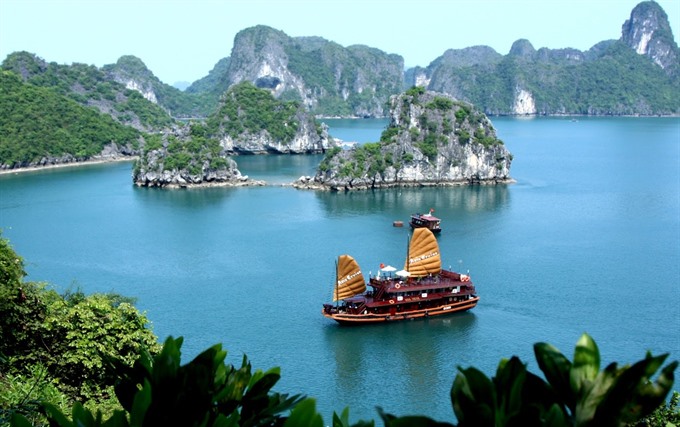 Life & Style
Life & Style

Việt Nam’s tourism has made great efforts to achieve its targets and hit many historic milestones in 2016, said Nguyễn Văn Tuấn, Director General of Việt Nam National Administration of Tourism (VNAT) at a press conference yesterday.
 |
| The Jewel of Asia: Hạ Long Bay, one of Việt Nam’s popular destinations to international visitors. The number of international tourists to the country is 10 million this year, setting a record to Việt Nam’s tourism sector. — Photo doanhnghiepvn.vn |
HÀ NỘI — Việt Nam’s tourism has made great efforts to achieve its targets and hit many historic milestones in 2016, said Nguyễn Văn Tuấn, Director General of Việt Nam National Administration of Tourism (VNAT) at a press conference yesterday.
The conference aims to review Việt Nam’s tourism in 2016 and announce the upcoming year’s targets.
Accordingly, domestic and international tourism numbers, as well as tourism revenue, set new records. Specifically, Việt Nam has welcomed 10 million international tourists (an increase of 25 per cent in comparison to last year), served 62 million domestic tourists and reached a total tourism revenue of VNĐ400,000 billion (US$18 billion).
The overall analysis of VNAT demonstrates that most of the international markets of Việt Nam’s tourism have seen an increase in 2016. First among this group is Northeastern Asia--including China, Japan and South Korea--accounting for about 30 per cent with high spending.
The number of tourists from Western Europe, including five countries exempted from visa: Italy, England, France, German and Spain, has also sharply increased by 16 per cent in comparison with the same period last year. Significant growth was also seen in Việt Nam’s biggest tourism market in Europe, Russia, as well as smaller-scale markets like Netherlands and Sweden.
Additionally, the effectiveness of the state administration and tourism human resources have been significantly enhanced, while the investment on the infrastructure and material facilities has been instantly stimulated in 2016.
This year has also seen the reinforcement in the activities promoting Việt Nam’s tourism and the launch of e-marketing campaigns that aim to improve the country’s image via mass media. Besides, tourism co-operation and products have received proper attention, while the central region has been supported to revive its tourism activities after the maritime environmental incident.
Also, according to Tuấn, VNAT will co-operate with Phú Quốc International Airport in the southern coastal province of Kiên Giang to welcome its 10 millionth foreign visitor from Britain this year on Christmas Day, December 25, together with the 9,999,999th from German and the 10,000,001th visitor from Sweden. Three lucky visitors, arriving in the same plane and going on vacation on Phú Quốc Island, will be presented with campaign medals and souvernirs.
However, beside the positive results, Việt Nam’s tourism still encounters many difficulties, including the sub-standard quality of services in several destinations, low competitiveness among regions and international markets, inadequate tourism administration, the occurrence of several tourism accidents, the lack of suitable management policies for special kinds of tourism and the limitedness in both quantity and quality of human resources.
According to Tuấn, the next target of Việt Nam’s tourism is welcoming 11,5 million of international tourists and 66 million domestic ones, earning a total revenue of VNĐ460,000 billion ($21 billion) in 2017. The tourism sector will be oriented to basically become the key industry of the country, he added.
Big investors
Addressing a meeting of the State Steering Committee on Tourism yesterday, Deputy Prime Minister Vũ Đức Đam urged localities to seek out big tourism investors in order to attract visitors.
The Deputy PM, also head of the committee, mentioned famous tourism spots like Tràng An (in Ninh Bình Province), Sầm Sơn (in Thanh Hoá), and Phú Quốc (in Kiên Giang) which have witnessed a huge influx of tourists after attracting big investment projects.
“Scattered development will not help attract tourists,” he said. “Localities with high tourism potential that have not been able to attract big investors should not be tempted to accept small ones. This will likely shatter or even smash tourism planning.”
According to Đam, the recent progress of the tourism sector is a result of close co-ordination among industries, sectors and intensive measures by localities.
Cities and provinces have worked hard to solve lingering problems that drive international tourists away, such as overcharging, begging, poor food hygiene and environmental pollution. Accommodation quality has been upgraded and tightened. Thirty-six hotels lost their stars as a result of sub-standard quality.
These activities should be kept up and each city and province should take responsibility for them, the Deputy PM asked. — VNS




